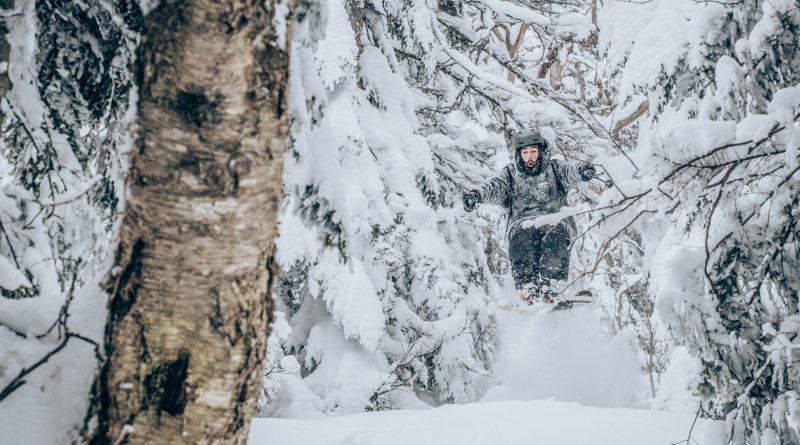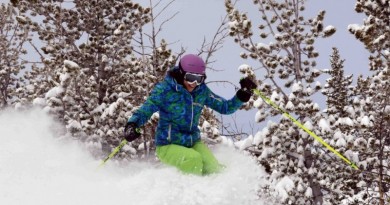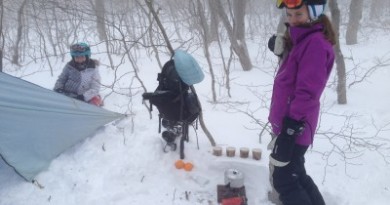The Wild Side: Pro Tips For Skiing Trees
Backcountry and sidecountry skiing are taking off around Vermont. Here are a few pro tips from Vermont’s top skiers and riders on how to ski the woods and where to get the goods.
Ready to take a ski on the wild side? Places such as Sugarbush’s Slidebrook Basin, Killington’s Natural Woods and the terrain off Stowe’s The Chin can challenge even the best skiers. So grab the fat boards and take some tips from extreme brothers John and Dan Egan, coaches Bud Keene and Doug Stewart and rising stars Dylan Dipentima and Tami Razinger.
John Egan: Extreme skier, Chief Recreation Officer, Sugarbush
“The biggest mistake I see people make is they look at the trees and not the spaces between. Also, someone who hasn’t skied the trees a lot will stop in the middle of a clearing. I tell clients to stop in a narrow spot or between trees, not in the wide open. That way when they start again, they are looking at open spaces, not the trees they have to go into.
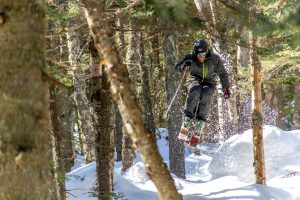
Some skiers fight gravity, rather than work with it. I try to tell my clients that it’s math and physics: you are part of the game, part of the gravitational forces carrying you down the mountain. You are body weight and momentum and you have to work with that, embrace it, become a part of it. When people are afraid, the human instinct is to back up and stop moving. Their reaction is, “Save me!” Instead, we should scrunch down, get aggressive and save ourselves, like any animal would do.
Sidecountry secrets: “Sugarbush’s Slide Brook Basin is pretty sweet; it’s a long run with a sustained pitch. There are three main runs in Slide Brook; I like the second entrance, it splits and divides and comes back together several times. It has nice variety and it’s the longest of the three. And Egan Woods are fantastic… that area has lift service, easy access and it’s nice and cleared out with a good fall line.”
Dylan DiPentima: 2015 Ski The East Freeride Tour Champ
“I really learned to ski the woods watching my coaches, Ryan Hawks and Lars Chickering-Ayer at Mad River Glen. They skied really fluidly and that’s what I try to do. If you are active with your legs, you can
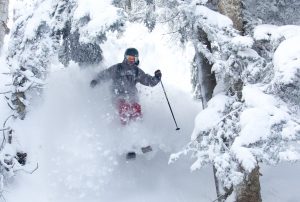
absorb the terrain and keep your upper body quiet. I ride my bike the same way, using my legs but staying still with my torso. Also, I try to ski the opposite line from everyone else so that I have fresh snow, which helps me ditch speed. Usually, everyone turns in the same place, going, left, right, left. If that’s the case, I go right, left, right.
Sidecountry Secrets: I love all the woods off Mad River Glen. You can usually go in there when there’s say, a 40-inch base versus the usual 50-inch base that I use as a gauge for elsewhere. That’s because there are so many skiers there who really help maintain the terrain.”
Bud Keene: Olympic Snowboard Coach
My advice pertains to both skiers and riders: Don’t go in alone. Go in pairs at a minimum—a threesome is even better. Wear a helmet and eye protection. Use equipment that’s shaped specifically to float on top of the snow. Look way ahead and pick your line.
Focus on the snow, not the trees. When faced with narrowing sections where you have to ride closely between trees, look ahead to see where the terrain opens up beyond. Then when you shoot through the narrow gaps and pick up a little speed, you can make a big power turn in the wider section to slow yourself back down.
One thing that’s different for snowboarders: You can’t pole, shuffle, herringbone, step up, or traverse directly across the fall-line as skiers can. That means you must always be traveling down the hill with a bit of forward momentum to avoid getting stuck. This is especially true when the snow is deep and even a modest downhill incline may not be steep enough to maintain forward progress.
Pick your line carefully with this is mind. When you do need to stop, to scope the terrain or communicate with your group, always make sure that you are either on or just above a pitch steep enough for you to slide down and continue without getting stuck.
Trust me, falling over, or simply coming to a stop on a snowboard on a flat pitch in the woods is a pain-in-the-you-know-what that you won’t want to repeat. It will happen to you – once. After thrashing,
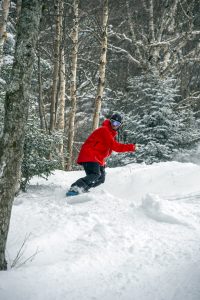
sweating, and fogging your goggles to extricate yourself, it (hopefully) won’t happen again.
Sidecountry secrets: I could tell you. But I’d have to kill you.
Doug Stewart: PSIA Examiner
“Skiing in the trees isn’t about high edge angles like carving on a groomer is. Instead, you should stay more over your feet and skis and pivot with your legs to turn. You do, of course, still tip the ski up a bit and use the edges, but riding high edge angles is not what’s going to turn our skis in the trees.
The modern all-mountain ski is made to do just that: turn in deeper snow. The wider waist—maybe from 90 mm to 100 mm for everyday Vermont off-piste terrain, and wider on a powder day—gives a bit of float and provides a nice platform to balance on.
The concept of having rocker in the profile of the ski is all about making the ski “loose” so it isn’t trying to engage the edges and it can pivot better. A traditional ski has full camber, which brings the tip and tail of the ski down toward the snow. That helps the ski engage the edges and “hook-up” with the snow even with very little tipping of the ski.
Having rocker in the tip or tail (or both) keeps the edges from engaging the snow until you tip the ski up on a high edge. This way a rockered ski can still carve on a trail when you are getting on a high edge, but can pivot a lot easier while skiing low edge angles.
Try turning your skis with very little edge angle on a groomed run. These types of turns will feel like you are drifting around, instead of carving or leaving a clean arc in the snow. In making these drifty turns, keep your upper body facing downhill, and allow your legs to make the turns. Your hips will be more a part of your upper body, while your legs will rotate in the hip socket and steer the skis from side to side.
Get so you can make short, quick turns like this. Once you have a nice, drifty, short turn on the groomers, it is time to get into the trees.
And when you do head into the woods, the three things I always mention are: pole straps off, goggles on, and look at the spaces, not the trees.
Sidecountry Secrets: My favorite sidecountry skiing is going out to The Bench from the gondola at Stowe. There are so many fun lines out there that it never gets old. I also love leaving the resort via the old Bruce Trail, and ending up at the Matterhorn for a drink after skiing. A beer tastes even better when you ski there!
Dan Egan: Extreme skier, host Dan Egan Ski Clinics
The last few years we’ve over-taught edging and people haven’t learned the art of feathering and slipping. That’s what you need to be good in the trees. Many people try carving, accelerate and then they get scared. The most important thing in the trees is to be able to check your speed. You need selective
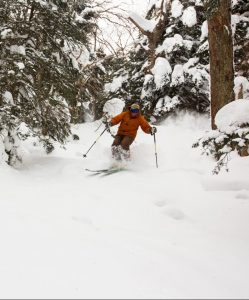
edge pressure, meaning: get into position before the turn (facing the fall line), apply a little edge pressure and then quickly release.
You always want to be in the fall line, making short turns and edging will take you across the fall line. The other thing is to plan your turns. Look ahead and decide where you are going to start and stop. That way you always stay in control.
Also, I ski in any weather, and to be a really good skier you need to feel the wind and know where it blew snow in and where it might have scraped snow away.
Sidecountry Secrets: Killington is great because it has everything—steeps, moguls, trees—and the whole area is open, including the 745 new acres known as the Natural Woods. Julio’s is awesome, as is all the stuff in the Canyon. The best part? All of this spills out to someplace where you can ride a lift back up. The area between Killington and Pico is amazing, too, but it’s easier to get lost there.
Tami Razinger: Competitor on Freeride World Qualifying Tour
When you head into the trees, you should always be thinking ahead. Look at least three turns ahead and look at the spaces between the trees, not the trees themselves.
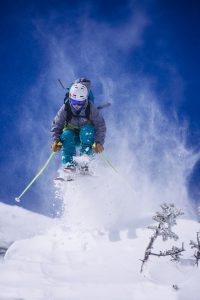
The most important thing when you are skiing uneven terrain is to keep your head up and keep looking forward. That way if you come to an obstacle or a small drop or cliff, you can check your speed or stop. Also, keep your knees loose.
If you do go over something, the tendency is to sit back, which is the worst thing you can do, and pretty much guarantees you have no chance of landing well.
If you keep your knees loose and absorbing impact, and your weight centered and charging forward, you can pretty much ski over anything. You just have to trust yourself.
Sidecountry secrets: I coach freeriding at Smugglers’ Notch, so I like everything off there, like the Birthday Bowls. I also like to hike The Chin from Stowe and ski Hellbrook and everything that spills you out onto the Notch Road.
Featured image by Peter Cirilli

